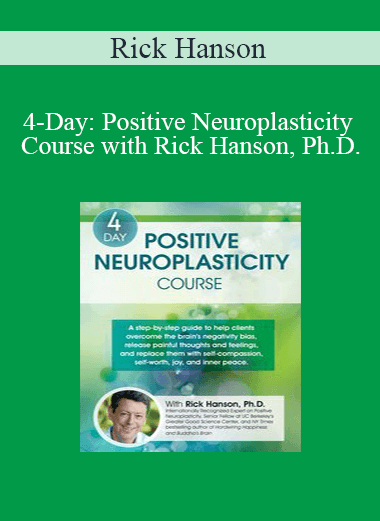Description
Buy Rick Hanson – 4-Day: Positive Neuroplasticity Course with Rick Hanson, Ph.D. Course at esyGB. You will have immediate access to the digital downloads in your account or your order email.
[Instant Download] – Immediately deliver the download link after receiving the payment
Purchase Rick Hanson – 4-Day: Positive Neuroplasticity Course with Rick Hanson, Ph.D. courses at here with PRICE $699.99 $132
- Faculty:
- Rick Hanson
- Duration:
- 24 Hours 12 Minutes
- Format:
- Audio and Video
- Copyright:
- Oct 21, 2019
Description
Outline
THE ESSENCE OF POSITIVE NEUROPLASTICITY: FUNDAMENTALS OF POSITIVE BRAIN CHANGE AND HOW TO MEET YOUR CLIENTS’ CHALLENGES BY HELPING THEM GROW DURABLE PSYCHOLOGICAL RESOURCES
The critical role of psychological resources to deal with clients’ challenges and vulnerabilities
- The stress-diathesis model: Challenges, vulnerabilities, resources
- Resources located in world, body and mind
- The special opportunity and value of mental resources
- Overview of mental resources (i.e., psychological resources) that are clinically relevant
- Why most of our mental resources are learned: acquired, not innate
- The necessary two stage process of any learning, including acquiring all mental resources: activation and installation
- Why experiencing doesn’t equal learning
- Why most therapeutic experiences do not have lasting value
- Activity: Help clients identify significant challenges and vulnerabilities, and then identify relevant psychological resources for these
The Neuropsychology of Learning
- The brain’s evolved negativity bias
- Clinical implications of the low conversion of therapeutic experiences to lasting changes of neural structure and function
- Major mechanisms of experience-dependent neuroplasticity
- What is positive neuroplasticity
- Activity: Discussion about the clinical implications of the negativity bias
- Activity: Explain the negativity bias to a client
Clients as Active Learners
- Environmental, behavioral and mental factors that increase learning, and thus the acquisition of psychological resources
- The special opportunity and value of mental factors of learning
- Empower clients to be active agents in their healing and growing
- Two kinds of mental factors: Contextual and engagement
- The opportunity and value of engagement factors
- Clinical benefits of clients actively engaging the experiences they are having to steepen their learning/healing/grown curves
- Activity: Experience the two-stage process of learning while using engagement factors
- Activity Explain the two-stage process of learning to a client, and then describe engagement-type mental factors of learning
The Three Ways to Engage the Mind Productively
- Letting go – observing, accepting, exploring the contents of consciousness
- Letting go – preventing, decreasing, or releasing negative or traumatic material
- Letting go – creating, sustaining, or increasing positive materials
- What is mindfulness; why mindfulness is part of letting go and letting in
- How letting be, letting go, and letting in form a natural healing sequence
- Activity: Experience the three ways to engage the mind
- Activity: Explain the three ways to engage the mind to a client
- Activity: Practice the three ways to engage the mind
Teaching Positive Neuroplasticity to Clients
- The science of positive neuroplasticity
- How to guide clients through experiential practices
- Identify and work through key blocks to having and internalizing beneficial experiences, such as distractibility, fear, shame, anxiety, social expectations and trauma
- Activity: How to explain positive neuroplasticity to a client
HAVING, ENRICHING, AND ABSORBING EXPERIENCES: HOW TO MAKE THE MOST OF THE POSITIVE EXPERIENCES CLIENTS ARE ALREADY HAVING, TURNING PASSING STATES INTO LASTING TRAITS
Overview of the HEAL Framework of Engagement Factors of Learning
- Have a beneficial experience
- Enrich it – increasing the neural activity underlying an experience
- Absorb it – increasing the sensitivity of the memory-making mechanisms of the brain
- Link positive and negative materials
- Activity: Experience the HEAL process
- Activity: How to explain the HEAL process to a client
Having Beneficial Experiences
- Notice beneficial experiences in the foreground and background of awareness
- Create beneficial experiences; overview of many ways to do this
- The five elements of an experience: Thoughts, perceptions, emotions, desires, actions; why each is an opportunity for acquiring an aspect of a psychological resource
- Deal with “yes, but” and other blocks to clients having beneficial experiences
- Activity: Experience the five elements present in an experience of playfulness
- Activity: Guide a colleague to be aware of the five elements present in an important experience
Enriching Experiences to Increase Their Neural Registration
- Five factors of Enriching: Duration, intensity, embodiment, novelty, salience
- Activity: These three factors applied to an experience of a psychological resource
- Activity: Explain these three factors to a client
- Activity Guide a colleague through using these three factors of Absorbing to deepen the internalization of an experience of psychological resource
LINKING POSITIVE AND NEGATIVE MATERIALS: USE POSITIVE MATERIALS TO SOOTHE, CONTEXTUALIZE, AND REPLACE NEGATIVE MATERIALS
Overview of Linking Positive and Negative Material
- Implicit and explicit memory
- How negative material is consolidated, activated, and reconsolidated in the brain
- The window of time during which the reconsolidation of negative material can be disrupted
- Three ways to manage negative material: Grow relevant psychological resources, associate positive to negative, disrupt the reconsolidation of the negative
- Self-compassion: A key resource for managing negative material, and an example of Linking
- Activity: Experience the Link step
- Activity: Explain the Link step to a client
- Activity: Guide a colleague through the Link step
Discussion and Application of Material Presented
- Four ways to use positive neuroplasticity and the HEAL framework with clients
- Adapt positive neuroplasticity for children
- Activity: Discussion with a colleague about using positive neuroplasticity and the HEAL framework with one or more challenging clients
- Activity: How to explain the Link step to a client
- Activity: Guide a client through the Link step
KEY PSYCHOLOGICAL RESOURCES: HOW TO IDENTIFY SPECIFIC PSYCHOLOGICAL RESOURCES THAT ARE MATCHED TO CLIENTS’ PSYCHOLOCIAL ISSUES
Our Three Needs and Two Ways of Meeting Them
- The three fundamental needs of any animal, including humans: Safety, satisfaction, connection
- The meeting of these needs through Avoiding harms, Approaching rewards, and Attaching to others
- Social brain theory
- Why there is more to human life avoiding pain and approaching pleasure
- The reptilian, mammalian, and primate/human stages of brain evolution and their relationship to the Avoiding, Approaching, and Attaching systems
- Our basic two ways of meeting needs: The Responsive and Reactive modes, without stress and with stress
- Explain what it means when clients go to Responsive mode and Reactive mode and the impact of each
- Activity: Discussion with a colleague about these three needs and two modes for meeting them
Identifying Key Psychological Resources Matched to Clients’ Needs
- Demonstration by instructor with a volunteer of identifying key resources
- Overview of resources for safety, satisfaction & connection
- The value in repeatedly internalizing experiences of needs sufficiently met
- The metaphors of repeatedly petting the lizard, feeding the mouse, and hugging the monkey
- Activity: Guide a colleague to identify key resources for an issue
- Activity: Experience of a basic sense of safety, satisfaction, and connection: peace, contentment, and love
Helping Clients to Identify and Internalize Key Psychological Resources
- Demonstrate by instructor with a volunteer of identifying and internalizing one or more key resources, using the HEAL framework
- Discussion of what helped this go well
- Activity: Guide a colleague to identify and internalize one or more key resources, using the HEAL framework
GROWING STRENGTHS FOR SAFETY: ESTABLISH A FOUNDATION OF CALM AND SAFETY IN WHICH CLIENTS CAN GAIN THE CONFIDENCE THEY NEED TO MEET CHALLENGES
Key Resources for Being and Feeling Safe
- Indicators of challenges to safety: fear, anger, helplessness
- Why we evolved to overestimate threats and underestimate opportunities and resources
- Blocks to reducing anxiety
- Activity: Experience of calm strength
- Activity: Experience of noticing you are basically alright right now
- Activity: Explain to a colleague how to have and internalize more experiences of calm strength and basic alright-ness, and feel less anxiety
Help Clients to Increase Resources for Safety
- Additional resources for safety: sense of agency, protection, and refuge
- Our vulnerability to acquiring learned helplessness
- Discussion of what helped this go well
- Special applications to trauma
- Activity: Guide a colleague to identify and internalize resources for being and feeling safer, using the HEAL framework
GROWING STRENGTHS FOR SATISFACTION: BUILD HEALTHY MOTIVATION IN CLIENTS AND HELP THEM SET UP AND ACHIEVE GOALS
Key Resources for Being and Feeling More Satisfied
- Indicators of challenges to satisfaction: Frustration, loss, ennui, boredom
- Ambition without driven-ness, aspiration without attachment
- Activity: Experience of gratitude and gladness
- Activity: Experience of goal accomplishment and feeling successful
- Activity: Explain to a colleague how to have and internalize more experience of gratitude, happiness, and success, and feel less frustration
Help Clients to Increase Resources for Satisfaction
- Liking and wanting in the brain; enjoy without craving
- How to use associational learning to increase motivation
- Special applications to addiction
- Activity: Guide a colleague to increase motivation for something, using the HEAL framework
GROWING STRENGTHS FOR CONNECTION: IMPROVE CLIENTS’ RELATIONSHIPS AND INCREASE THEIR SENSE OF SELF-WORTH
Key Resources for Being and Feeling More Connected
- Indicators of challenges to connection: hurt, rejection, loneliness, hatred, inadequacy, shame
- Normal narcissistic needs
- Activity: Experience of feeling cared about and caring
- Activity: Guide a colleague through internalizing psychological resources for greater self-worth, using the HEAL framework
Help Clients to Increase Resources for Connection
- Three neural circuits of empathy
- The strong heart: combining kindness and assertiveness, love and power
- Activity: Explain the circuits of empathy to a client and exploring how the client could be more emphatic in daily life
- Activity: Guide a colleague the psychological resources that support the strong heart, and how to have and internalize experiences of these resources
Managing Challenges From the Responsive Mode
- Activity: Experience of peace, contentment, love
- Activity: Explore with a colleague how to manage a key challenge from the Responsive mode, including what this would be like and feel like
- Activity: Guide a colleague through having and internalizing an experience of a key resource for managing challenging from the Responsive mode, using the HEAL framework
APPLICATIONS AND IMPLICATIONS: LEARN HOW TO ADAPT AND APPLY THESE METHODS TO MEET A VARIETY OF NEEDS AND SITUATIONS
Use Positive Neuroplasticity and the HEAL Process for Particular Clinical Issues and Situations
- In mindfulness training
- With depression
- Specific issues from participants
- Activity: Discussion with a colleague about applications to one or more clients
Clinical Consequences of Societal Factors
- How economic, cultural, and other environmental factors affect mental health, for better or worse
- How internalizing psychological resources and living increasingly from the Responsive mode helps people be less vulnerable to manipulations of fear and anger, possessiveness and greed, and grievance and vengeance toward others
- Final discussion
- Activity: Experience of peace, contentment and love
LIMITATIONS OF THE RESEARCH AND POTENTIAL RISKS
Faculty
![Rick Hanson - 4-Day: Positive Neuroplasticity Course with Rick Hanson, Ph.D. | eSy[GB] Rick Hanson, Ph.D.'s Profile](https://cdn.ce21.com/images/gyc27ricm0240dsnc4xea.png)
Rick Hanson, Ph.D. Related seminars and products: 13
Rick Hanson, Ph.D., is a psychologist, a Senior Fellow of the Greater Good Science Center at UC Berkeley, and a New York Times best-selling author. His books are available in 28 languages and include Buddha’s Brain (New Harbinger, 2009), Just One Thing (New Harbinger, 2011), Hardwiring Happiness (Harmony, 2016), Resilient (Harmony, 2018), Just One Thing Card Deck (PESI, 2018), and Mother Nurture (Penguin, 2002). He edits the Wise Brain Bulletin and has numerous online programs. A summa cum laude graduate of UCLA and founder of the Wellspring Institute for Neuroscience and Contemplative Wisdom, he’s been an invited speaker at NASA and Google, and Oxford, Stanford, Harvard, and other major universities, and taught in meditation centers worldwide.
Dr. Hanson has been a trustee of Saybrook University, served on the board of Spirit Rock Meditation Center, and was president of the Board of FamilyWorks, a community agency. He began meditating in 1974, trained in several traditions, and leads a weekly meditation gathering in San Rafael, California. His work has been featured on the BBC, CBS, and NPR, and over 140,000 people receive his free Just One Thing weekly newsletter.
He enjoys rock-climbing and taking a break from emails. He and his wife have two adult children.
Speaker Disclosures:
Financial: Rick Hanson is in private practice. He receives a speaking honorarium from PESI, Inc.
Non-financial: Rick Hanson has no relevant non-financial relationship to disclose.
Purchase Rick Hanson – 4-Day: Positive Neuroplasticity Course with Rick Hanson, Ph.D. courses at here with PRICE $699.99 $132
Buy the Rick Hanson – 4-Day: Positive Neuroplasticity Course with Rick Hanson, Ph.D. course at the best price at esy[GB]. Upon completing your purchase, you will gain immediate access to the downloads page. Here, you can download all associated files from your order. Additionally, we will send a download notification email to your provided email address.
Unlock your full potential with Rick Hanson – 4-Day: Positive Neuroplasticity Course with Rick Hanson, Ph.D. courses. Our meticulously designed courses are intended to help you excel in your chosen field.
Why wait? Take the first step towards greatness by acquiring our Rick Hanson – 4-Day: Positive Neuroplasticity Course with Rick Hanson, Ph.D. courses today. We offer a seamless and secure purchasing experience, ensuring your peace of mind. Rest assured that your financial information is safeguarded through our trusted payment gateways, Stripe and PayPal.
Stripe, known for its robust security measures, provides a safe and reliable payment process. Your sensitive data remains confidential throughout the transaction thanks to its encrypted technology. Your purchase is fully protected.
PayPal, a globally recognized payment platform, adds an extra layer of security. With its buyer protection program, you can make your purchase with confidence. PayPal ensures that your financial details are safeguarded, allowing you to focus on your learning journey.
Is it secure? to Use of?
- Your identity is kept entirely confidential. We do not share your information with anyone. So, it is absolutely safe to buy the Rick Hanson – 4-Day: Positive Neuroplasticity Course with Rick Hanson, Ph.D. course.
- 100% Safe Checkout Privateness coverage
- Communication and encryption of sensitive data.
- All card numbers are encrypted using AES with a 256-bit key at rest. Transmitting card numbers occurs in a separate hosting environment and does not share or store any data.
How can this course be delivered?
- After your successful payment this “Rick Hanson – 4-Day: Positive Neuroplasticity Course with Rick Hanson, Ph.D. course”, Most of the products will come to you immediately. But for some products were posted for offer. Please wait for our response, it might take a few hours due to the time zone difference.
- If this occurs, please be patient. Our technical department will process the link shortly after, and you will receive notifications directly via email. We appreciate your patience.
What Shipping Methods Are Available?
- You will receive a download link in the invoice or YOUR ACCOUNT.
- The course link is always accessible through your account. Simply log in to download the Rick Hanson – 4-Day: Positive Neuroplasticity Course with Rick Hanson, Ph.D. course whenever you need it.
- You only need to visit a single link, and you can get all the Rick Hanson – 4-Day: Positive Neuroplasticity Course with Rick Hanson, Ph.D. course content at once.
- You can choose to learn online or download for better results, and you can study anywhere on any device. Please ensure that your system does not enter sleep mode during the download.
How Do I Track Order?
- We promptly update the status of your order after your payment is completed. If, after 7 days, there is no download link, the system will automatically process a refund.
- We value your feedback and are eager to hear from you. Please do not hesitate to reach out via email us with any comments, questions and suggestions.




 Purchase this course you will earn
Purchase this course you will earn ![Tai Chi Chin Na - Yang Jwing Ming | eSy[GB] Yang Jwing Ming Tai Chi Chin Na | eSy[GB]](https://esygb.com/wp-content/uploads/2021/06/Yang-Jwing-Ming-Tai-Chi-Chin-Na.jpg)
!['Quantum' Chakra Clearing and Balancing Series - Jonette Crowley | eSy[GB] 'Quantum' Chakra Clearing and Balancing Series - Jonette Crowley](https://esygb.com/wp-content/uploads/2021/05/Quantum-Chakra-Clearing-and-Balancing-Series-–-Jonette-Crowley.jpg)
![CSW 2012 Camp - Erik Paulson | eSy[GB] Erik Paulson CSW 2012 Camp | eSy[GB]](https://esygb.com/wp-content/uploads/2021/06/Erik-Paulson-CSW-2012-Camp.jpg)
![Train Your Mind for Athletic Success - Mental Preparation to Achieve Your Sports Goals - Jim Taylor | eSy[GB] Jim Taylor Train Your Mind for Athletic Success Mental Preparation to Achieve Your Sports Goals | eSy[GB]](https://esygb.com/wp-content/uploads/2021/06/Jim-Taylor-Train-Your-Mind-for-Athletic-Success-Mental-Preparation-to-Achieve-Your-Sports-Goals.jpg)
![Qigong 101 - Flowing Zen | eSy[GB] Flowing Zen Qigong 101 | eSy[GB]](https://esygb.com/wp-content/uploads/2021/06/Flowing-Zen-Qigong-101.jpg)
![CSW Student Level 1-10 - Erik Paulson | eSy[GB] Erik Paulson CSW Student Level 1 10 | eSy[GB]](https://esygb.com/wp-content/uploads/2021/06/Erik-Paulson-CSW-Student-Level-1-10.jpg)